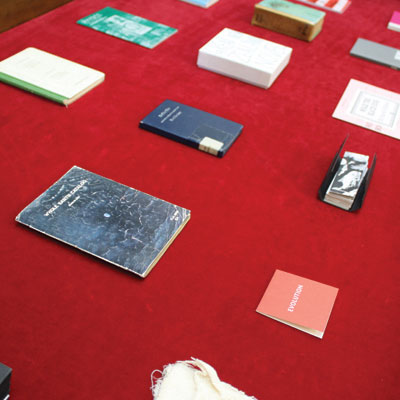
Little books on display
“It may seem a small gesture – for an artist to take a recognisable object and re-present it in smaller or larger proportions – but the implications are far greater: to change the size of an object is to disrupt everything, from its form and function to its interpretation and meaning.”1
Currently on display at the Fine Arts Library is a suite of little books ranging from 7 to 16cm in size. Among these small books are exhibition catalogues, guides and maps small enough to carry in a pocket. These books have been designed to accompany the reader through an exhibition, inviting a rhythm of consulting and pocketing, reading and storing. Then there are items that create the illusion of movement, as in Louise Menzies’ flip book Homecoming. Some items economise text while others, despite their small size, contain entire anthologies of stories.
Simon Denny’s artist’s book Mini Fall 1969 Whole earth catalog is the complete reproduction of an existing publication in miniature. Scaled down from its original A3 format to A6 and printed on translucent paper, the text becomes almost unreadable. Consequently, the text becomes secondary to the book as an object.
Cloud book work by John Reynolds, similarly asserts itself as an object, mirroring the small scale of the approximately 7000 canvases that appeared in his installation Cloud, presented at the 2006 Bienniale of Sydney.
As Michael Fried discusses in his seminal essay Art and Objecthood, “the larger the object, the more we are forced to keep our distance from it”.2 And so, the scaling down or production of an object in miniature, invites the opposite response, to move closer to the object, to be drawn in towards it.
S. Foote, Fine Arts Library
1 Size Matters: Exploring Scale in the Arts Council Collection. London: Arts Council Collection, Hayward Gallery, 2005. p.9
2 Fried, Michael. Art and Objecthood : Essays and Reviews. Chicago: University of Chicago Press, 1998. p.153
